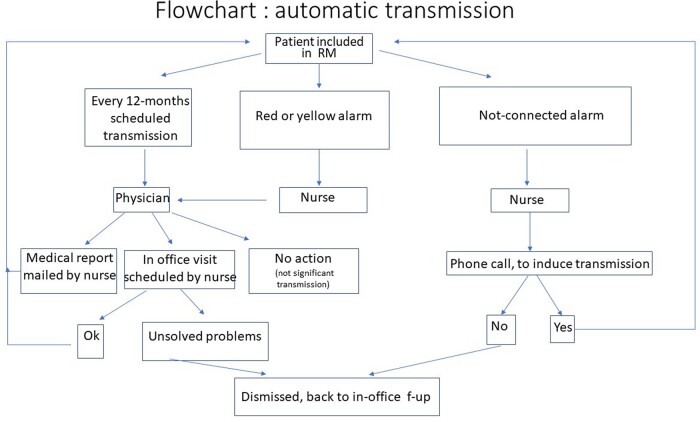Abstract
Funding Acknowledgements
Type of funding sources: None.
Introduction
During the SARS-CoV-2 COVID-19 pandemic, the global health system has had to review important processes involved in daily routines such as outpatient activities within the hospital, including follow-up visits of implantable cardiac electronic devices (CIEDs), pacemakers (PMs) and implantable defibrillators (ICDs) carried out in office. The aim of this study was to prospectively evaluate the success rate of remote transmissions of all devices followed by the CIED control clinic and verify the adopted organizational models.
Methods
All patients with remote monitoring system were considered in the study if automatic algorithm such as autocapture and autosensing were activated and well-functioning. Between January 2021 and November 2022, they were completely followed by remote monitoring and called for unscheduled in-office visit only because of remote yellow or red alarms. Patients were divided into two groups: Manual Transmission System (MTS) and Automatic Transmission System (ATS), based on the available technology. Organizational models shown in figures 1-2, were followed for the two groups. The technology of the ATS group, in addition to ensuring a daily transmission of any yellow or red alarms, allowed a control of missed communication at least every 14 days. The MTS group provided a manual transmission every 6 months. The ATS group was controlled at least once in the year, even if no alarms occurred.
Results
At the end of 2022 a total of 1193 patients were followed remotely by our center. Of these, 238 from the MTS group and 955 from the ATS group. 3314 remote transmission required medical intervention, which generated 182 unscheduled outpatient visits, mainly due to lack of transmission for prolonged periods, failure of the autocapture test and newly onset atrial fibrillation. 3496 transmissions were generated and 120 transmissions were missed; the overall success rate of transmissions with the organizational model adopted was 96.6% (connectivity index). On average, the monthly rate of unconnected manual devices was 5.1% while 3.5% for automatic devices. 2-year mortality was 12.7%.
Conclusions
By adopting an appropriate organizational model, it is possible to maintain high transmission success rates. The available technology allows you to change hospital outpatient habits in the cardiology field for CIED checks and move to a virtual clinic safely. The automatic transmission technology allows a more frequent control of patients with CIED, the impact on the patients' health must be assessed.
Fig. 1
Fig. 2




